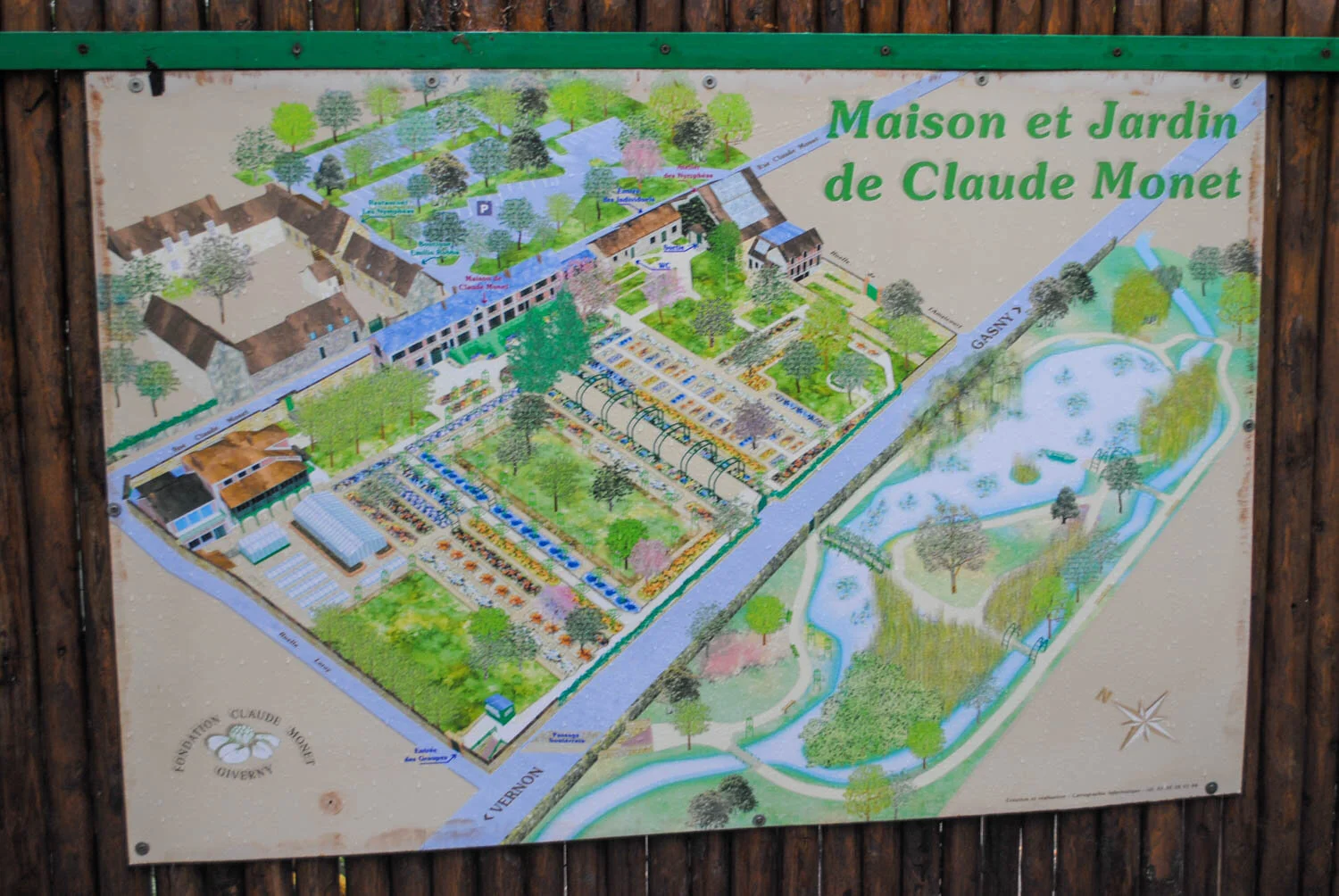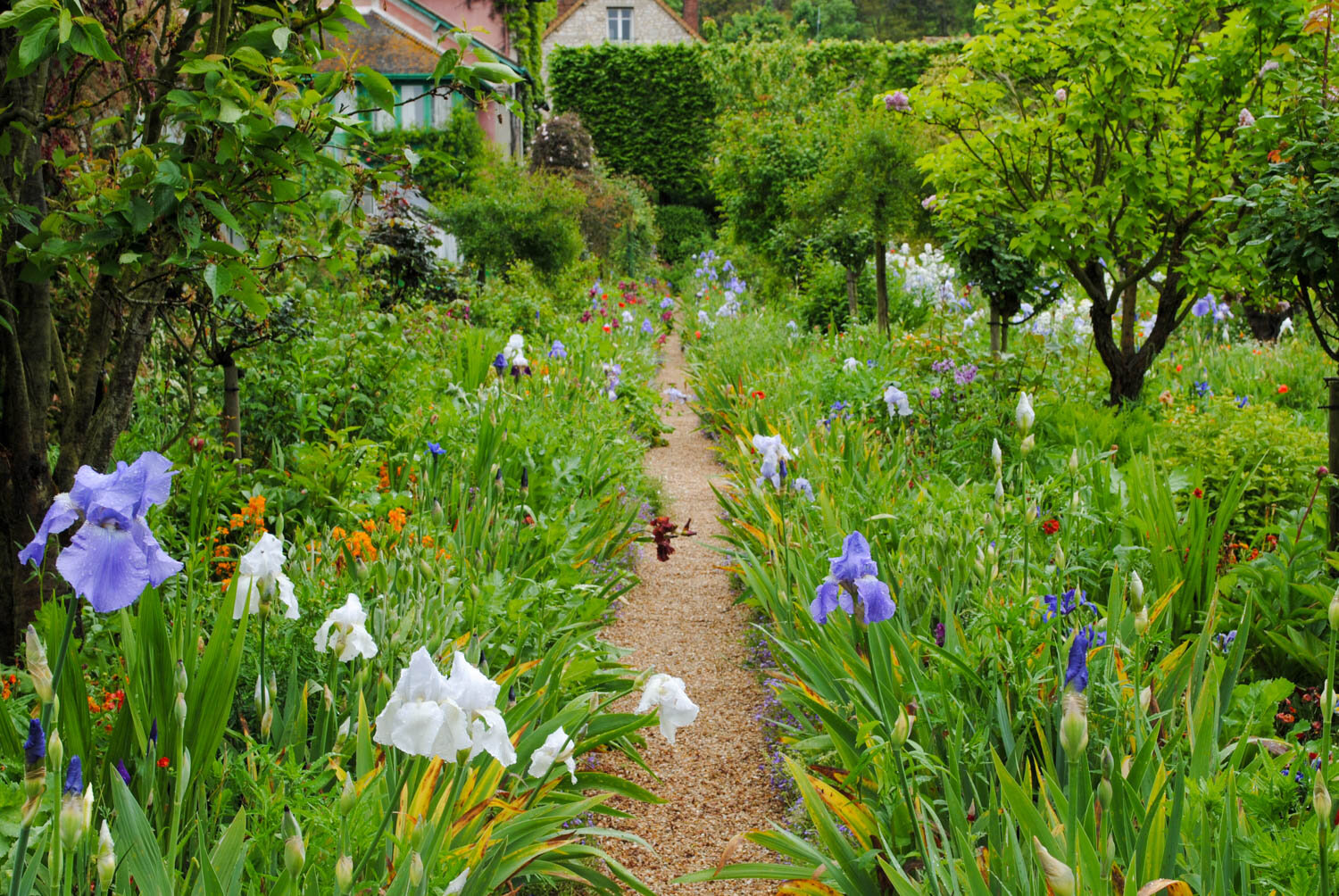I didn't know much about Monet before I went to France. I knew he was a painter, that he had a garden, and that he had a bridge in his garden where he had painted water lilies.
But, after visiting his garden in Giverny, I feel so connected with him and his work. I learned that he was a horticulturist. In Monet’s Passion, Elizabeth Murray shared that Monet wrote that his garden was his “greatest form of art” and “I perhaps owe having become a painter to flowers.” He sounds like my kind of guy! I also came to really know impressionism, this style of painting where instead of focusing on details you capture a snapshot view of a landscape at a time.
This map should provide you with an overall impression of Monet’s garden. To the right is the water garden, and in the middle is the Clos Normand. The hoops within this garden frame the Grand Allée and frame a primary axis that runs from the house into the water garden. The light blue are the streets, not waterways.
The trip was part of a study abroad expedition that I helped lead in 2016 with our students. We arrived at his garden in Giverny on a cloudy day that teased rain. Our guide Leif enriched the experience during our tour. He shared with us that Monet was one of the artists that started the impressionism movement; even the phrase impressionism comes from Monet's painting Impression, Sunrise. This method became popular because of two inventions—photography and paint in tubes. The former inspired people to no longer desire to capture every detail in a painting since they had the technology to do that in an instant; the latter allowed people to leave their workshops and painting studios, head to the countryside, and paint plein air instead of what they saw on a table.
The Water Garden
We first saw the water garden, a later addition for Monet that he acquired after he bought the house and garden property. He designed the two-acre water garden to be a mirror that would reflect flowers, clouds, trees, or whatever nature could offer. And, to fill the garden with water, he had to actually convince the locals to divert water from a stream that fed into the nearby River Epte. Monet also offered to pave the barren road that ran between his house and water garden for the community with gravel to reduce the amount of dust on the plants.
Eventually, his garden grew to the point he hired gardeners to care for the place. The waterlily gardener had special tasks. When Monet was painting waterlilies, this individual had to come out early in the morning and remove the pond of any debris and any past prime flowers.
Monet’s two-acre waterlily garden was lush and green but too early for many waterlilies to be blooming. Note how the water reflects trees, sky, and color on the shore.
Here is a glance the other direction at the bridge that he painted.
And, here is a photo for comparison I took a few days later from Musee d'Orsay in Paris of Le Bassin Aux Nymphéas, harmonie rose (water lily basin, pink harmony). I was so touched by impressionism that I used part of a free day to go see more of Monet’s paintings.
Lupinus and Digitalis frame this view of the smaller bridge at the other end of the water garden.
A glance up one of the streams that feeds the water garden. Laburnum and Rhododendron punctuate the edges with color.
Clos Normand and Grand Allée
From the water garden we then crossed over to the main garden called the Clos Normand. This part of the garden was designed with beds of plants that radiated out from the house. At first, Monet cared for and tended to his garden throughout the day. Even his children had to haul buckets from the well to water the garden. But, eventually Monet’s popularity as an artist would allow him to hire a five-person gardening staff.
This space was an experimental canvas where he was able to play with the way light interacted with the different plants. Monet went out to paint at different times to capture the ambiance he saw. He painted at breakfast, ate lunch, then went back out to paint in the afternoon. Monet had to paint quickly because he wanted to capture a point in time. Thus, his canvases should be viewed at a distance because it's broad brush strokes, just like how we should see a garden instead of focusing on every individual plant.
The Grand Allée in its spring attire looking toward Monet’s house.
A close up of one side of the allée planted heavily with a white form of Hesperis matronalis.
Next to the Grand Allée was the start of this series of straight paths that were planted with herbaceous plants. Larger roses or trees were a little further off the pathway.
This pathway was planted with blue Iris and set to line up perfectly with the window in the background, no doubt to create an interesting vista from within the house as well.
This path was a little further away from the Grand Allée and featured more color and larger trees framing it on either side.
From this cross image of the Clos Normand you really can’t make out the pathways. Instead it is a myriad of colors. Note the absence of much texture. Monet is said to have focused on color instead of having much winter interest.
In parts of the Clos Normand garden, espaliers framed the plantings. I loved this green approach to edging.
Beyond the espaliered fence was a lawn where they had allowed the bulb foliage to remain and die naturally to maximize flowers for next year.
Near Monet’s house, chickens were even given a place to roam.
COLOR COMBINATIONS
The garden was rife with color pairings. His garden was different from the typical French style of manicured shrubs and tapestry plantings because it was so saturated with color. And, even 100 years later his passion as a colorist lives on in this place with the combinations created by the gardeners today.
A warm color scheme of azaleas and various other herbaceous plants livens up the waterlily garden.
Here Hesperis and Digitalis play off a purple pairing.
In parts of the Clos Normand garden, the gardeners created these color gradients. This one shifts from yellow in the foreground through white, red, orange, and pink as you look closer and closer toward the house.
From a slightly different angle, you can see the blocks of colors.
Who says you can’t pair orange and pink… and a multitude of other colors!
And, I just had to share one of my favorite plants, Nectaroscordum siculum. Their rosy petals erupt and combine well with so many different flowers.
I love the chandelier architecture of this Nectaroscordum siculum flower and so wish we could grow it in Texas.
Up near the house, I admired this Erysimum flower choice to match the color of the paint.
GIVERNY
After visiting the garden, we walked the quaint streets of Giverny to make our way to Hotel Baudy for lunch. This establishment became famous for the mingling of artists that visited to learn from Monet as the the town became know for its hub of impressionism.
We had a delicious lunch at Hotel Baudy, a meeting place for artists back in Monet’s day.
And, of course, I just HAD to try their creme brulee.
After lunch we walked the streets admiring the lovely town that Monet used to call home. Here a small courtyard in Giverny is flanked by Iris and Vitis.
Even the signs coordinate with the flower color on this Salvia.
Throughout Giverny I noticed the subtle pairings of colors, like this Salvia officinalis ‘Tricolor’ with the mauve petals of a clambering Clematis.
And, at the impressionism museum, color combinations continued like this planting that screams gold and orange.
While we didn’t have time to go through the Museum of Impressionisms, we did walk the grounds a bit. I liked the poppies here, perhaps an allude to Monet’s The Poppy Field?
A modern take on one of Monet’s paintings as we crossed the road to head back. Monet was able to enrich our world with art because plants enriched his.
We left Giverny and Monet’s garden filled with the beauty we had seen. I wish we could have stayed longer, but the schedule held more riches for the day in the promise of seeing Le Jardin Plume.
It still amazes me that Monet attributed his origins of great art to flowers. May we all strive to find such inspiration in the plants around us just like Monet did.































